You can Download KSEEB Solutions for Class 8 Science Chapter 16 Light Questions and Answers Pdf, Notes help you to revise the complete syllabus.
KSEEB Solutions for Class 8 Science Chapter 16 Light
Light Textbook Questions and Answers
Question 1.
Suppose you are in a dark room. Can you see objects in the room? Can you see objects outside the room? Explain.
Answer:
We cannot see objects in the darkroom. But, we can see objects outside the room, in case there is light outside the room. To see objects, we need light which must reflect from the object to the eyes.
![]()
Question 2.
Differentiate between regular and diffused reflection. Does diffused reflection mean the failure of the laws of reflection?
Answer:
| Regular reflection | Diffused reflection |
| (i) It takes place on a smooth surface. | (i) It takes place on a rough surface. |
| (ii) All the reflected rays are in parallel. | (ii) Reflected rays are parallel. |
| (iii) Reflected rays are in one direction. | (iii) Reflected rays are scattered in different directions. |

No, Diffused reflection is not the failure of the laws of reflection.
Question 3.
Mention against each of the following whether regular or diffused reflection will take place when a beam of light strikes. Justify your answer in each case.
- Polished wooden table
- Chalk powder
- Cardboard surface
- Marble floor with water spread over it
- Mirror
- The earthquake can be predicted in advance.
Answer:
- A polished wooden table will have regular reflection because its surface is smooth.
- A chalk powder will get the diffused reflection because chalk particles are not smooth i.e it is rough.
- The cardboard surface has minute irregularities on it, so it will have a diffused reflection.
- Marble stone with spread over it will have regular reflection if water is stable but if waves are formed then diffused reflection will take place.
- A mirror will reflect light regularly due to its smooth surface.
- A piece of paper will have irregular reflection due to minute irregularities on it.
![]()
Question 4.
State the laws of reflection.
Answer:
Following are the laws of reflection:
- The incident ray reflected ray and normal drawn at the point of incidence to the reflecting surface always lie in the same plane.
- The angle of incidence is always equal to the angle of reflection.
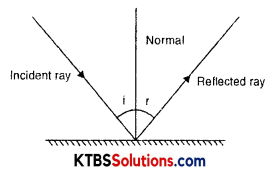
Question 5.
Describe an activity to show that the incident rays, the reflected ray, and the normal at the point of incidence lie in the same plane.
Answer:
Take a plane mirror and make it stand with help of a block on a plane sheet as shown in the figure. Now draw an incident line on it AB. Now see in the mirror and mark the points on the paper, where you feel the line is travelling after getting reflected from the mirror (P1 and P2). Now remove the mirror and mark it as sand join the points to make the reflected ray BC.
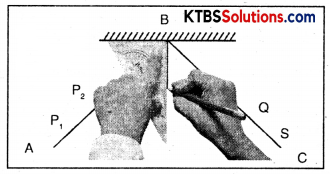
Question 6.
Fill in the blanks in the following:
- A person 1 m in front of a plane mirror seems to be _________ m away from his image.
- If you touch your _________ ear with your right hand in front of a plane mirror it will be seen in the mirror that your right ear is touched with _________
- The size of the pupil becomes _________ when you see in dim light.
- Night birds have _________ cones than rods in their eyes.
Answer:
- A person 1 m in front of a plane mirror seems to be 2 m away from his image.
- If you touch your left ear with your right hand in front of a plane mirror it will be seen in the mirror that your right ear is touched with your left hand.
- The size of the pupil becomes large when you see it in dim light.
- Night birds have fewer cones than rods in their eyes.
![]()
Choose the correct option in Questions 7-8.
Question 7.
The angle of incidence is equal to the angle of reflection:
(a) Always
(b) Sometimes
(c) Under special conditions
(d) Never
Answer:
(a) Always
Question 8.
The image formed by a plane mirror is:
(a) Virtual, behind the mirror, and enlarged.
(b) Virtual, behind the mirror and of the same size as the object.
(c) Real at the surface of the mirror and enlarged.
(d) Real, behind the mirror and of the same size as the object.
Answer:
(b) Virtual, behind the mirror and of the same size as the object.
![]()
Question 9.
Describe the construction of a kaleidoscope.
Answer:
We take three-mirror strips of the same shape and size and join them together to make a triangular tube. We make sure that the shiny sides of all the mirrors are on the inside. Now we fix them in place with rubber bands. We paste butter paper on one end of the tube and put broken pieces of glass bangles in the tube. We paste a piece of transparent paper (mellophone) or glass on the other end and hold the end with butter paper towards a source of light and look into the tube through the other end. On moving the tube, we will see beautiful shapes.

Question 10.
Draw a labelled sketch of the human eye.
Answer:
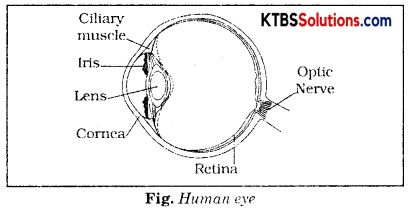
Question 11.
Gurmit wanted to perform Activity 16.8 using a laser torch. Her teacher advised her not to do so. Can you explain the basis of the teacher’s advice?
Answer:
The teacher has advised her not to use a laser torch because laser light is harmful to the eyes and can cause some permanent damage to the eyes when directly in the eyes.
Question 12.
Explain how you can take care of your eyes?
Answer:
The following care should be taken to keep our eyes healthy and free from any defect:
- We should not look at the sun or a powerful light source directly.
- Too little or too much light is bad for the eyes. Insufficient light causes eye strain and headaches. Too much light, like that of the sun, or powerful lamps, can injure the retina, which is very delicate.
- If advised, suitable spectacles should be used.
- We should wash our eyes frequently with clean water.
- We should always read from a normal distance for distinct vision and not read by bringing the book too close or keeping it too far.
- We should never rub our eyes if any small particle of dust goes into our eyes. Instead, eyes should be washed with clean water and if the condition does not improve, a doctor should be consulted.
- If food is deficient in some components, the eye may also suffer. Lack of vitamin A in our diet is responsible for many eye troubles. The most common amongst them is night blindness. Therefore, to get rid of this, we must include in diet components which have vitamin A.
![]()
Question 13.
What is the angle of incidence of a ray if the reflected ray is at an angle of 90° to the incident ray?
Answer:
The angle of incidence is 45°.
(As the angle of incidence = Angle of reflection)
Question 14.
How many images of a candle will be formed if it is placed between two parallel plane mirrors separated by 40 cm?
Answer:
The infinite number of images of the candle will be formed if it is placed between two parallel plane mirrors.
Question 15.
Two mirrors meet at right angles. A ray of light is incident on one at an angle of 30° as shown in Fig. 16.19. Draw the reflected ray from the second mirror.
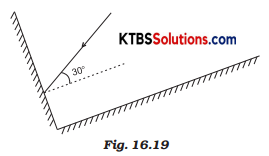
Answer:
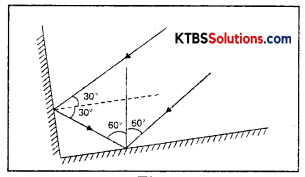
Question 16.
Boojho stands at A just on the side of a plane mirror as shown in Fig. 16.20. Can he see himself in the mirror? Also, can he see the image of objects situated at P, Q, and R?
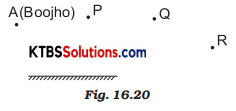
Answer:
Boojho will not be able to see himself in the mirror. But he can see images of objects situated at P and Q. He cannot see objects situated at R.
![]()
Question 17.
(a) Find out the position of the image of an object situated at A in the plane mirror (Fig.).
(b) Can Paheli at B see this image?
(c) Can Boojho at C see this image?
(d) When Paheli moves from B to C, where does the image of A move?
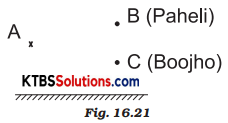
Answer:
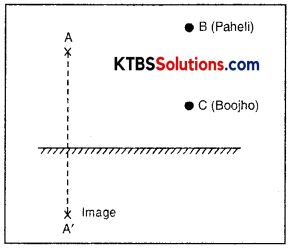
(a) The image will be formed at the same distance behind the mirror as the distance between mirror and A.
(b) Yes, Paheli from B can see the image.
(c) Yes, Boojho from C can see the image.
(d) The image remains at the same place. The image moves only if the object of the mirror is moved.
Light Additional Questions and Answers
Question 1.
Mention two characteristics of light.
Answer:
Two characteristics of light are:
- It enables us to ‘see’ objects in the beautiful and colourful world around us.
- It provides us means of communication.
Question 2.
Write the three properties of light.
Answer:
The three properties of light are:
- Light travels in a straight line.
- Reflection.
- Reflection.
Question 3.
What are incident ray and reflected ray?
Answer:
The light ray, which strikes any surface, is called the incident ray. The ray that comes back from the surface after reflection is known as the reflected ray.
![]()
Question 4.
What is the angle of incidence and angle of reflection?
Answer:
The angle between the normal and incident ray is called the angle of incidence (∠i). The angle between the normal and the reflected ray is called the angle of reflection (∠r).
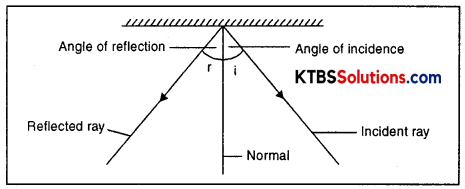
Question 5.
Can the reflected rays be further reflected if incident on another mirror?
Answer:
Yes, reflected rays can be further reflected if incident on another mirror.
Question 6.
How can you see the hair at the back of your head?
Answer:
The back of the head can be seen due to the reflection of light from the mirror placed at the back of the head.
Question 7.
What happens if two plane mirrors are used in combination?
Answer:
A number of images are formed if we place two mirrors at an angle to one other. This is used in Kaleidoscope.
![]()
Question 8.
What is meant by spectrum? Name the colours of the spectrum in their order.
Answer:
The band of seven colours dispersed by a glass prism is known as a spectrum. The seven colours in a spectrum are violet, indigo, blue, green, yellow, orange, and red known as VIBGYOR.
Question 9.
Name the most valuable and sensitive sense organs, which nature has endowed on us to see the wonderful world of light and colour.
Answer:
The Human eye.
Question 10.
Draw a labelled diagram of the human eye. Explain the structure of the eye.
Answer:

The eye consists of:
- Eyeball: It is nearly spherical in shape. It preserves the shape of the eye and protects it from injury.
- Eye lens: The eye lens is in the front of the eyeball. It makes a real and inverted image of the objects on the retina. It is held in its place by ciliary muscles attached to the eyeball.
- Ciliary muscles: The ciliary muscles surrounding the eye lens can increase or decrease the thickness of the lens, thus making its focal length shorter or longer.
- Retina: The retina is a thin tissue that has many layers of cells. It consists of nerve cells that are sensitive to the brightness as well as to the colours of light. The nerve cells carry messages about the image from the retina to the brain in the form of special signals. The brain then interprets these signals and enables us to see the objects.
- Iris: Iris is the coloured part of the eyes. It controls the amount of light that can pass through the eye lens to the retina.
- Pupil: The dark spot in the center of the iris is called the pupil. The pupil is the opening of the eye.
- Cornea: It is a thin layer of transparent material covering the iris. The main function of the cornea is to protect the eyes. It also helps in focusing light.
Question 11.
Write some precautions which must be taken to protect our eyes.
Answer:
The precautions taken to protect our eyes are:
- We should wash our eyes at least twice a day with clean cold water.
- We should not use too bright or too dim light while reading or doing work that requires a close look.
- We should raise our eyes from time to time while reading, watching television, or doing work that requires a close look.
- We should not read in a moving bus, car, or train.
- We should never rub our eyes if something gets into them.
- We should play carefully and pay attention to sharp projections.
- In the event of injury, we must consult a doctor.
- We should not squeeze our eyes to see. In case it happens then we must consult the doctor.
![]()
Question 12.
How do persons become visually challenged?
Answer:
Persons become visually challenged because of injury to:
- Any part of the eye, which propagates light (cornea, pupil, eye len).
- Retina.
- Optic nerve.
Activities
Activity 1.
Fix a white sheet of paper on a drawing board or a table. Take a comb and close all its openings except one in the middle. You can use a strip of black paper for this purpose. Hold the comb perpendicular to the sheet of paper. Throw light from a torch through the opening of the comb from one side (Fig.). With a slight adjustment of the torch and the comb, you will see a ray of light along with the paper on the other side of the comb. Keep the comb and the torch steady. Place a strip of the plane mirror in the path of the light ray (Fig.).
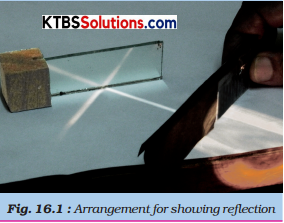
Question (i).
What do you observe?
Answer:
After striking the mirror, the ray of light is reflected in another direction.
![]()
Activity 2.
Perform Activity 1 again. This time use a sheet of stiff paper or chart paper. Let the sheet project a little beyond the edge of the Table (Fig.). Cut the projecting portion of the sheet in the middle. Look at the reflected ray. Make sure that the reflected ray extends to the projected portion of the paper. Bend that part of the projected portion on which the reflected ray falls. Can you still see the reflected ray? Bring the paperback to the original position. Can you see the reflected ray again?
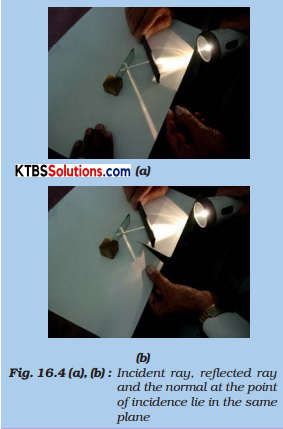
Question (i).
What do you infer:
Answer:
The incident ray, the normal at the point of incidence, and the reflected ray all lie in the same plane.
Activity 3.
A source of light O is placed in front of a plane mirror PQ. Two rays OA and OC are incident on it (Fig.). Can you Find out the direction of the reflected rays?
Draw normals to the surface of the mirror PQ, at points A and C. Then draw the reflected rays at points A and C. How would you draw these rays? Call the reflected rays AB and CD, respectively. Extend them further.
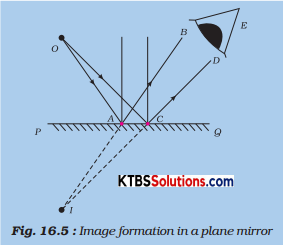
Question (i).
Do they meet? Extend them backward. Do they meet now?
Answer:
Yes. The reflected ray on the extension will meet at a point.
![]()
Activity 4.
Imagine that parallel rays are incident on an irregular surface as shown in Fig. Remember that the laws of reflection are valid at each point of the surface. Use these laws to construct reflected rays at various points.

Question (i).
Are they parallel to one another?
Answer:
No, the reflected rays are not parallel to one another.
Activity 5.
Take two plane mirrors. Set them at right angles to each other with their edges touching (Fig.). To hinge them you can use adhesive tape. Place a coin in between the mirrors.
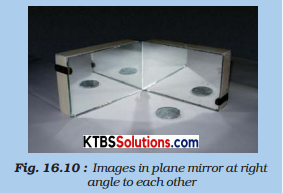
Question (i).
How many images of the coin do you see (Fig.)?
Answer:
Four
![]()
Activity 6.
Get a plane mirror of a suitable size. Place it in a bowl (Katori) as shown in Fig. Fill the bowl with water. Put this arrangement near a window in such a way that direct sunlight falls on the mirror. Adjust the position of the bowl so that the reflected light from the mirror falls on a wall. If the wall is not white, fix a sheet of white paper on it. The reflected light will be seen to have many colours.
Answer:

Activity 7.
Look into your friend’s eye. Observe the size of the pupil. Throw light on her eye with a torch. Observe the pupil now. Switch off the torch, and observe her pupil once again.
Question (i).
Do you notice any change in the size of the pupil? In which case was the pupil larger? Why do you think it was so?
Answer:
When the light from the torch falls on the pupil, its size becomes smaller to allow less amount of light to enter into the retina.
When the light was not falling on the pupil, its size was bigger, to allow more light to enter into the retina.
It happened so as to control the amount of light entering the eye.
Question (ii).
In which case do you need to allow more light in the eye, when the light is dim or bright?
Answer:
When the light is dim, we need to allow more light in the eye.
![]()
Activity 8.
Get a square piece of cardboard of size 6 – 8 cm. Make two holes as shown in Fig. Thread a string through the two holes. Draw/paste a cage on one side of the cardboard and a bird on the other side. Twist the string and make the card twirl rapidly.
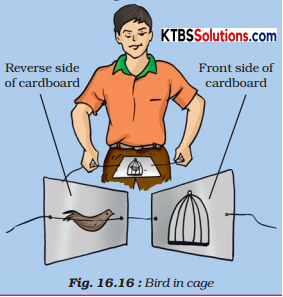
Question (i).
Do you see the bird in the cage?
Answer:
Yes, I can see.